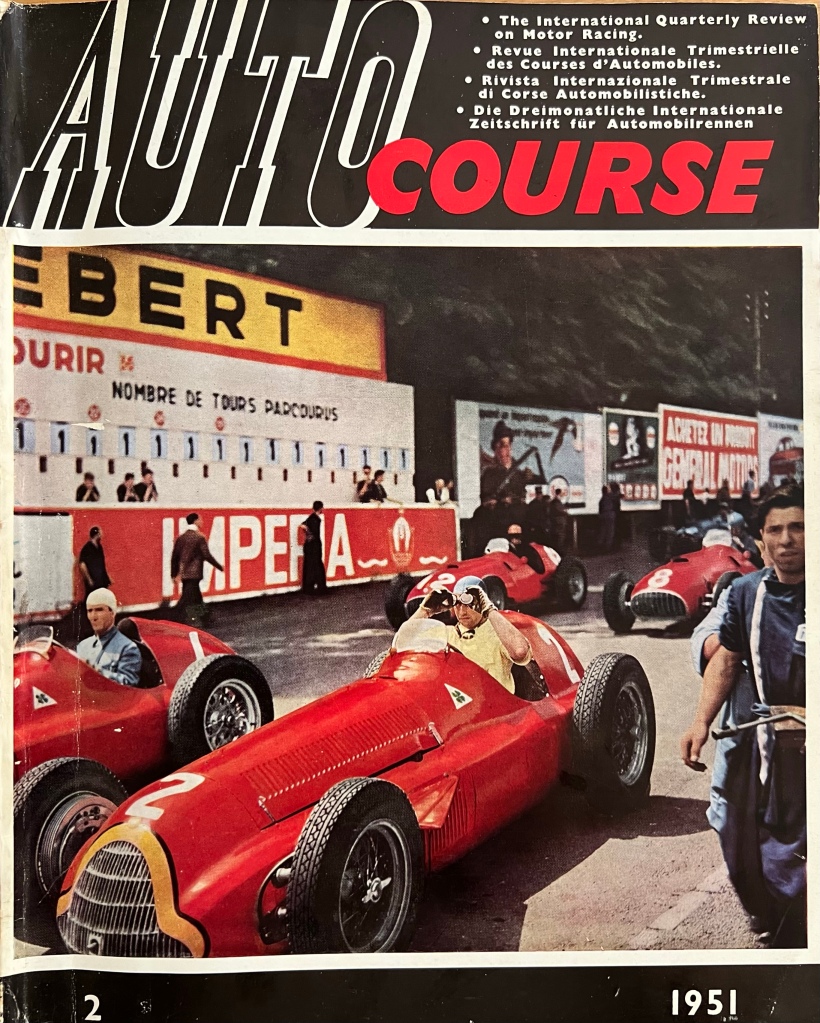
This is the second in an occasional series of articles plucked from the early issues of Autocourse, via the collection of my friend, racer and historian, Tony Johns.
In the unlikely event one could find Formula 1 articles of a technical type amongst all of the ‘Drive to Survive’ inspired dull, shit-boring, insipid dross in most magazines these days, one on racing spark plugs would be the last to expect!
These days they are a purchase-instal-and-forget item but once upon a time one’s méchanicien needed to be able to anticipate, read, and change plugs to suit the changing weather and other circumstances throughout a race weekend. Remember the shots of a mechanic labouring in the pits and paddock under big wooden boxes of plugs?
This article was written by Herr G Werner, a Bosch employee.
Oh yes, the opening shot is before the off, Spa, the Grand Prix de Belgique, June 17, 1951. Juan Manuel Fangio #2 is on pole in his Alfa Corse Alfa Romeo 159 with Giuseppe Farina alongside in another Alfa; the 1951 and 1950 World Champions of course. Farina won from the pair of Scuderia Ferrari Ferrari 375 V12s driven by Alberto Ascari and Luigi Villoresi.
Car #12 on the second row is Piero Taruffi’s Ferrari 375 (DNF rear axle) and #8 Ascari. Farina took 2hr 45min 46.2sec to complete the 36-lap, 316-mile race through the daunting, high speed swoops and dives of the Ardennes road circuit.
Fangio finished ninth and last. He was gradually catching Farina in the lead, when he pitted for fuel and tyres after 14 laps but no amount of hammering by the mechanics of the left rear wheel would move it (below). In the end the poor technicians removed the brake drum and wheel assembly, losing nearly 15 minutes in total. Fangio rejoined last of the remaining ten runners and four laps adrift of Farina.
Autocourse notes the following in relation to the Fangio and Farina 159s, “Fitted with an oval-section petrol tank each side of the driver extending forwards to the bulkhead and an oval-section tank on the right-hand side of the engine under the exhaust manifold. Fangio’s car had a De Dion back axle.”
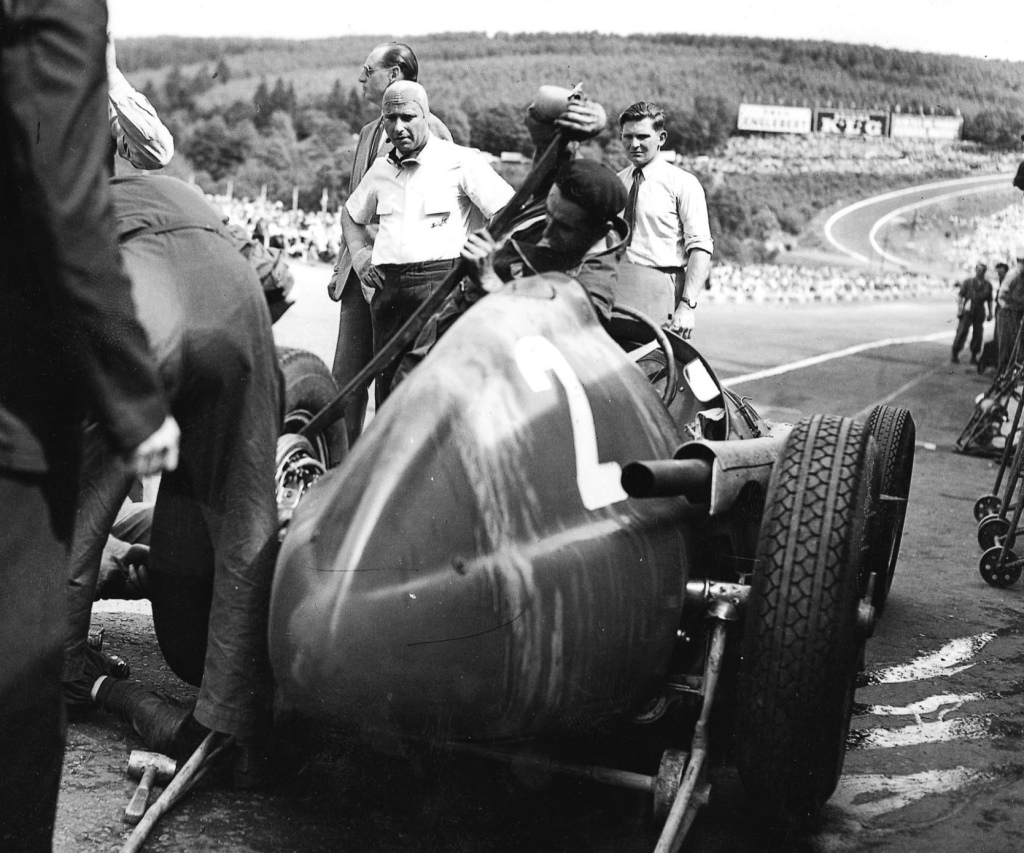
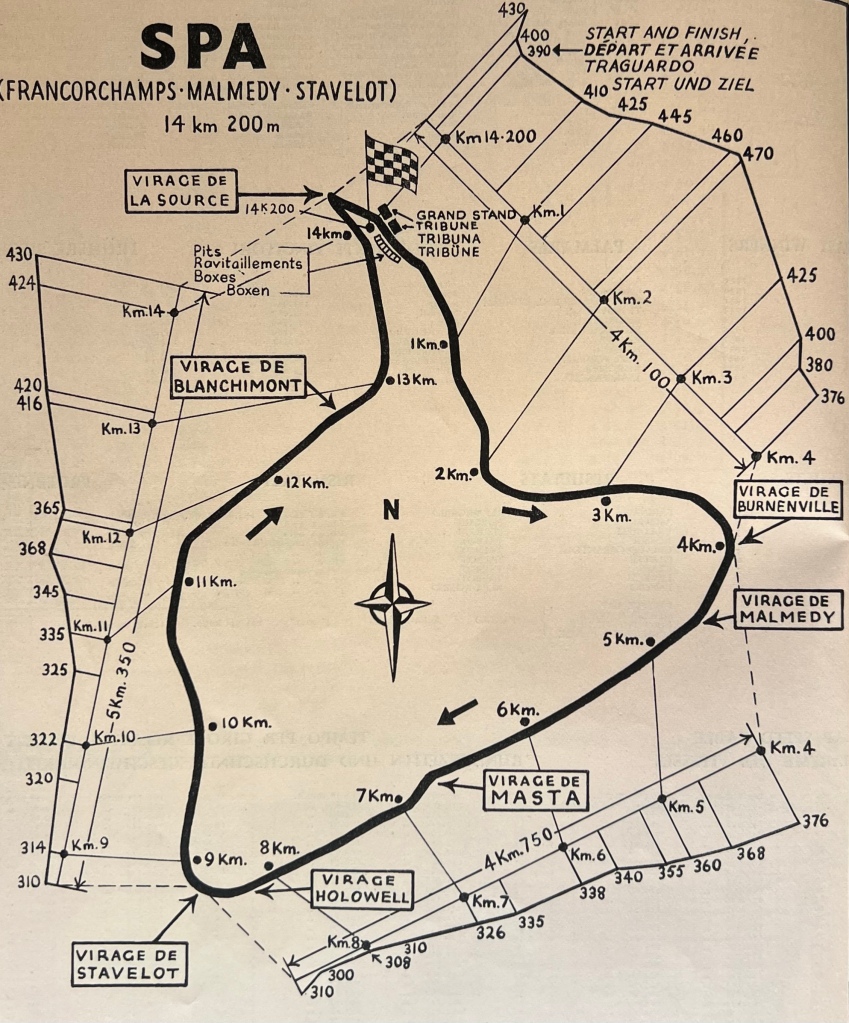
The Racing Plug : Its selection and the factors which influence its efficiency
Much has been written about sparking plugs. A whole science has evolved around them and their correct choice, and they have been become an inexhaustible theme for discussion at large motor sport events. A glance at the problem of the correct choice of sparking plugs will prove ample justification for this.
The purpose of our article is the discussion of the “Racing Plug”. Although its construction and requirements are entirely different from those of a normal plug, they have nevertheless many things in common.
One thing is expected from every type of plug. At exactly the right moment it must produce a sufficiently powerful spark for the fuel mixture in the cylinder of the engine to be ignited and for the chemical energy of the fuel to be converted into heat and work, thus giving life to the engine.
For obvious reasons a racing engine makes more specialised demands on the construction and material of the plug than does an ordinary engine. The right choice of a racing plug for a particular race needs much experience and knowledge of the many factors which play their part in the functioning of the plug. These problems will shortly be considered.
For every race the type of track and its length are common knowledge. The tuning of the engine develops from these known facts and from the conditions laid down in the regulations.
The type of fuel to be used will be either prescribed or left to choice. On it depends the compression ratio, the carburettor adjustment, the degree to which the ignition is to be advanced and, of course, the sparking plug itself. The length of the race and the engine’s performance determine the fuel consumption and accordingly the number of stops required for refuelling during long races. Fuels with a high alcoholic content raise problems different from petrol, benzol or a mixture of these two.
A two-stroke engine using a fuel-oil mixture requires a different plug from a four-stroke engine.
The weather is also a factor to be taken into consideration, as changes may occur between practice days and the actual day of the race. Even the most ideal carburettor and ignition adjustments may have to be changed if, for example, it is raining on the day of the race whilst during practice it was bright and dry.
We need hardly tell the experts, whether firms or individuals, how to adjust their engines so as to be “fit” for a particular race, but there are the younger ones without the experience of the more seasoned enthusiasts to whom perhaps a few hints might be of value. If amongst these tips there is something new to the old hands, we shall be doubly rewarded.
We feel that perhaps fifty years’ experience of plugs has given us some authority and we make no apology for stating our views.
I. What sparking plugs are required when the length and conditions of the race are known ?
This question, in so far as heat value is concerned, will, in most cases, be resolved after practice, but to some extent the driver must know the sort of plug he requires, at least the plug thread-either 18 mm. or 14 mm. thread diameter and 12 1/2 mm. or 18 mm. reach.
2. The higher the compression ratio, r.p.m. and consequently the engine pertormance, the higher the heat value of the plug must be, if self-ignition is to be avoided
3. Tracks which have no gradients and where corners can be taken without loss of speed present no great difficulty in the choice of the right heat value of the plug. Then, a high heat value and consequently a cold or hard plug is preferable as there is less danger of the plug becoming dirty or oily.
4. On tracks with steep gradients and many corners when brakes and accelerators are much in use it is different.
When decelerating and consequently pouring less fuel mixture into the cylinder a momentary depression results in the combustion chamber. This causes oil to seep through the piston rings which brings with it a danger of the plugs getting oily and the formation of a carbon deposit. If carbon enters the plug, it may well stop the plug from firing, as carbon is an electrical conductor. This conductor may cause a short and instead of the plug sparking, the impulse will be diverted to the secondary circuit. It will be seen therefore that conditions demand special care in the choice of plug, as it is important to ensure that the plug does not become overheated during long races on fast circuits.
On the other hand the plug must not become oily when braking at corners or descending slopes; it must reach such a temperature to ensure that all the carbon is burnt up thus avoiding the formation of a secondary circuit. This temperature is approximately 500 degrees centigrade at the points.
5. If the driver removes his plug during practice after a fast run and discovers (generally by means of a magnifying glass) that a fine light grey metal deposit, the size of a microscopic pearl, has formed on the electrodes and insulator, then there has been an error, even if, according to the driver’s opinion, the engine has been running well. This metal deposit means that the ignition was too advanced and that there is a burning of the piston. Here, too, it may be advisable to use a colder plug with a correspondingly higher heat value. But the most important factor of all is a correct ignition adjustment.
6. The metal washer between the plug and the engine must not be forgotten. This washer must fit well but not too tightly. If too tightly fitted, then the piece between the thread and the plug body will become strained and looseness will result. The looseness brings about a deterioration of the thermal conductivity in the inner part of the plug which causes overheating.
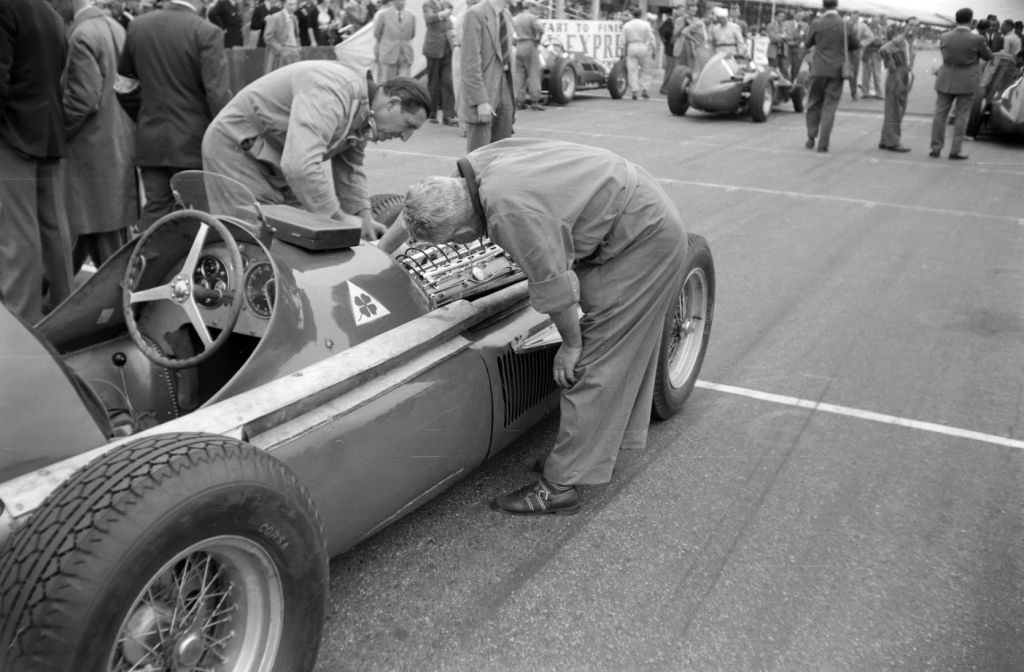
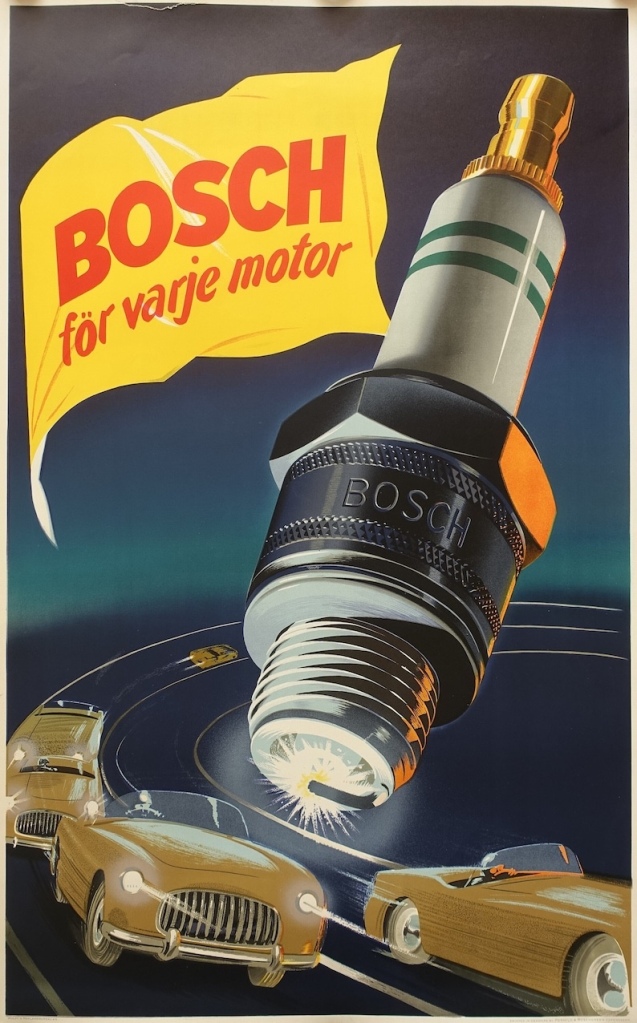
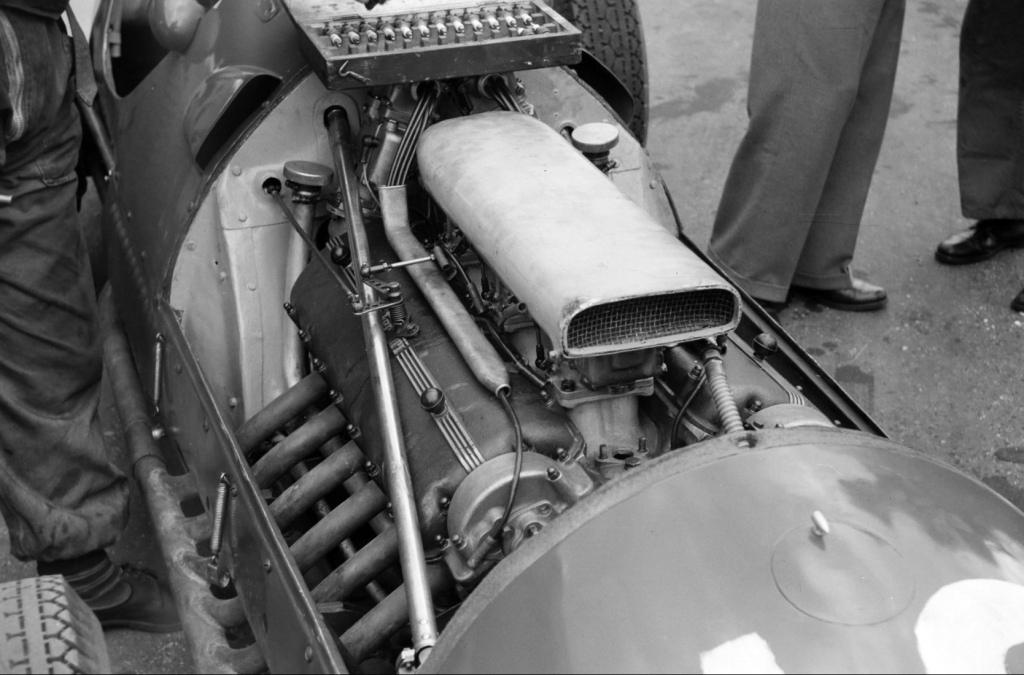
7. If the compression ratio of the engine is raised with a consequent increase in output, the temperature of the exhaust gas from the engine itself becomes relatively cooler. The ultimately greater output is due to the fact that more heat is converted into energy; thus proportionately less heat passes unused from the exhaust pipe.
The implication is that the engine would now appear to run cooler, and the most suitable plug would be one with a lower heat value. This, however, is not the case. Although the greater amount of heat converted into energy in the engine’s combustion chamber-the most economical use of the fuel-leads to a relatively lower temperature, the combustion gas temperature in the chamber itself and also of the plugs, pistons and valves become higher as the amount of heat being converted is greater. It will be realised, therefore, that a high compression ratio demands a correspondingly high heat value of the plug and therefore a colder one.
8. The amount that the ignition is advanced measured in the degrees of the angular movement of the crankshaft or in the mm. of the stroke, greatly influences the output and particularly the temperature of the plugs, the piston and valves. The more advanced the ignition, the longer the period of contact between the flame and the plug, the piston and valves, which naturally become correspondingly hotter. If the ignition is advanced then a colder plug with a higher heat value is necessary. It is, of course, well known that the ignition must be advanced when the amount of engine revolutions is increased.
9. No alteration can be made to the plug seat or to the position of the plug unless the cylinder-head is altered. Nevertheless it may be said that the shape of the combustion chamber as well as the position of the plug and of the ignition spark are of great importance to starting and accelerating and to the output of the engine.
10. The selection of the plug for a two-stroke racing engine, running on a mixture of fuel and oil should not be more difficult than the selection of a plug for a four-stroke engine. It has to be remembered of course, that fuel, to which oil has been added in the ratio of 1 : 15 or 1 : 20 requires a rather warmer plug as the danger of it getting dirty and of carbon forming is greater than with a four-stroke engine. Therefore a plug with too high a heat value should not be chosen.
11. In general the heat value of a plug for an air-cooled engine should be somewhat higher than for a water-cooled engine. The plug should be cooler for the simple reason that with an air-cooled engine the rate of loss of temperature from the plug to the cylinder is smaller and therefore the cylinder and the plug seat become hotter.
12. It should be said that in principle the temperature of the water in a water-cooled engine has little influence on the temperature of the plug. Therefore the water temperature should have little bearing on the choice of the heat value of the plug.
13. The type of fuel used has the greatest influence, not only on the output of the engine, on the fuel consumption and on the number of refuelling stops during long races, but also on the carburettor adjustment. In view of the large output required, the adjustment of the carburettor must be generous. This adjustment may well cause the plug to get dirty and especially will have an influence on the temperature of the plug in use.
It is well known that a fuel with a high alcohol content allows for high compression and therefore an increased output. As alcohol possesses a high vaporization heat, the engine, and to a certain degree, the plug, remain cool.
Unfortunately, the self-ignition temperature of the alcohol fuels is considerably lower than that of petrol and benzol. Therefore, self-ignition may take place, in spite of the fact that the knocking resistance of alcohol is higher than of hydrocarbon fuels, i.e., petrol and benzol.
14. It is hardly necessary to mention that should the engine, pistons, piston-rings, cylinder sleeve, valves, etc., be in bad condition, this may be responsible for the plug getting oily or dirty.
15. The weather, in particular, has a great influence on the selection of plugs. Not only the team manager, the driver and the mechanics, but also those who are responsible for plug service, may consider themselves lucky if the weather during the actual race remains the same as during practice.
If during practice the weather is hot and dry and the plugs are selected accordingly, but on the day of the race it is cold and rainy, then in most cases a new plug which gets warmer, i.e., with a lower heat value, must be selected. Conversely, if the weather changes change from cold and rain during practice to dry during the race, a higher heat value, ie, a colder plug is indicated.
The weather indeed poses a problem for plugs, but generally it is fair to say that the height of the barometer is proportional to the height of the heat value of the plug.
It is beyond the scope of this article to go into the many factors which influence ignition and the many different stages of combustion. Theses subjects will be dealt with at some later date.
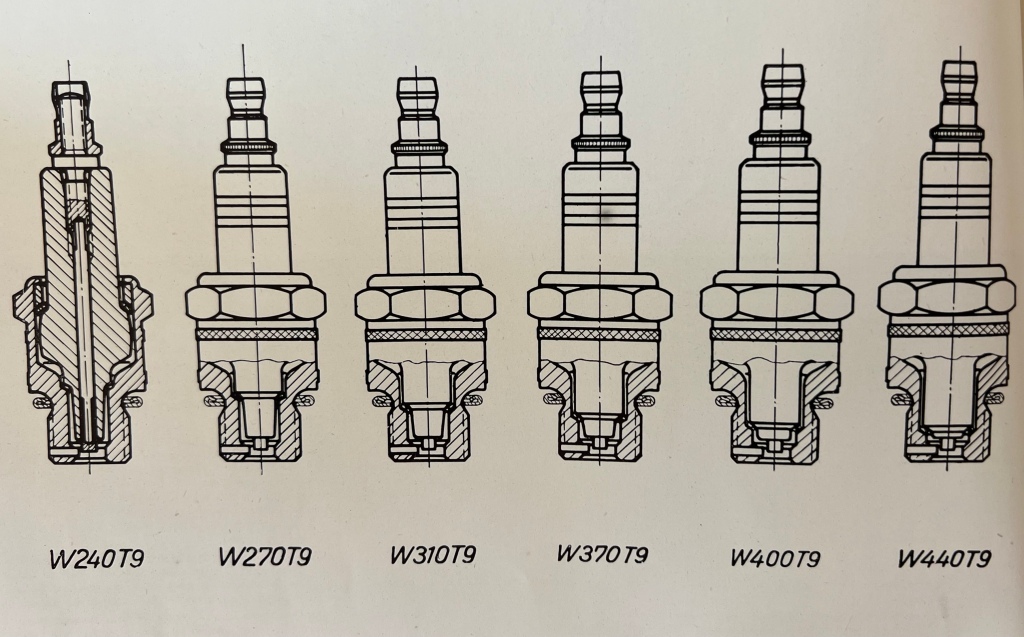
From left to right a typical range of racing plugs shown in assembling order of hardness. It will be seen that the gas volume in the mouth of the plug decreases with the plug’s increasing ability to stand heat.
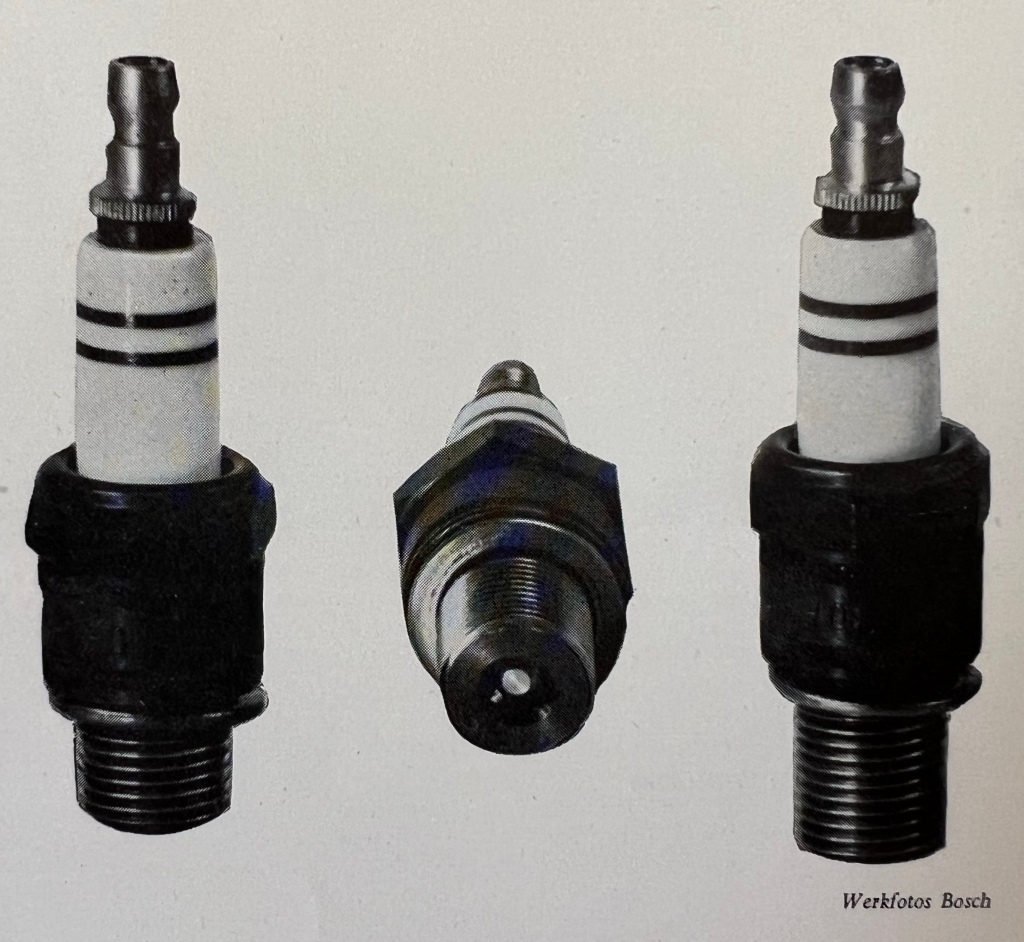
This photograph shows Bosch racing plugs with a thread of 3/4 and 1/2 inch. For alloy cylinder heads the longer thread is used to safeguard against stripping while the shorter thread is quite satisfactory for cast heads. The plug lying in the middle shows the centre and earth electrodes and the spark gap.
Credits…
Autocourse No 2 1951, Editor Stanley Sedgwick. Tony Johns Collection
Tailpiece…
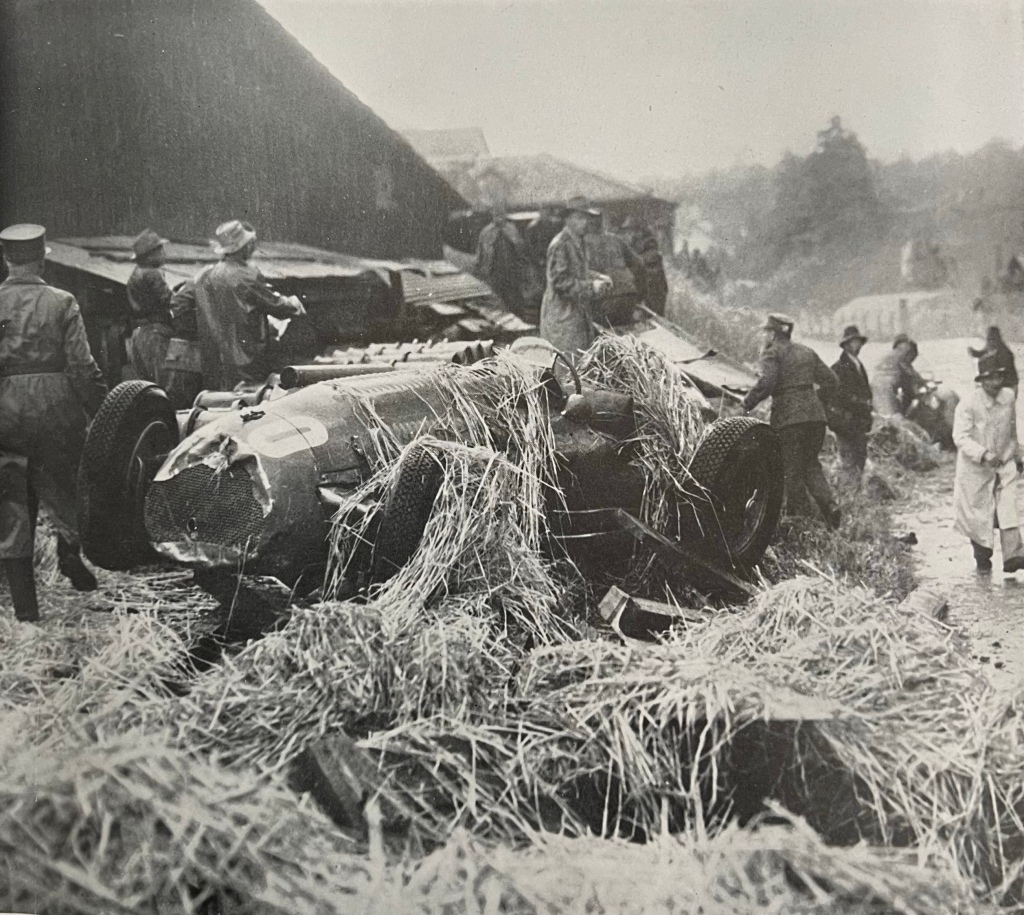
“Louveau’s car after running out of road and overturning’. Swiss Grand Prix, Bern, May 27, 1951.” It looks like quite an accident…
Bern’s 4.52-miles wasn’t for the faint heated either, especially in the wet. “Henri Louveau ran out of road on (lap 31) the fast corner after passing the pits, overturning his Talbot , and sustained a broken leg.” He qualified his Ecurie Rosier Talbot-Lago T26C 11th of 21 starters in his second and last championship GP start. The race was won by Fangio from Taruffi. More about Louveau here: https://www.f1forgottendrivers.com/drivers/henri-louveau/
Autocourse described the challenges of the place thus, “The Bremgarten Circuit at Berne is at the same time perhaps the most beautifully situated and the most exacting course in Europe. The bends, curves, corners and gradients make constant demands upon both drivers and cars and the thickly-wooded stretches leave no margin for error.”
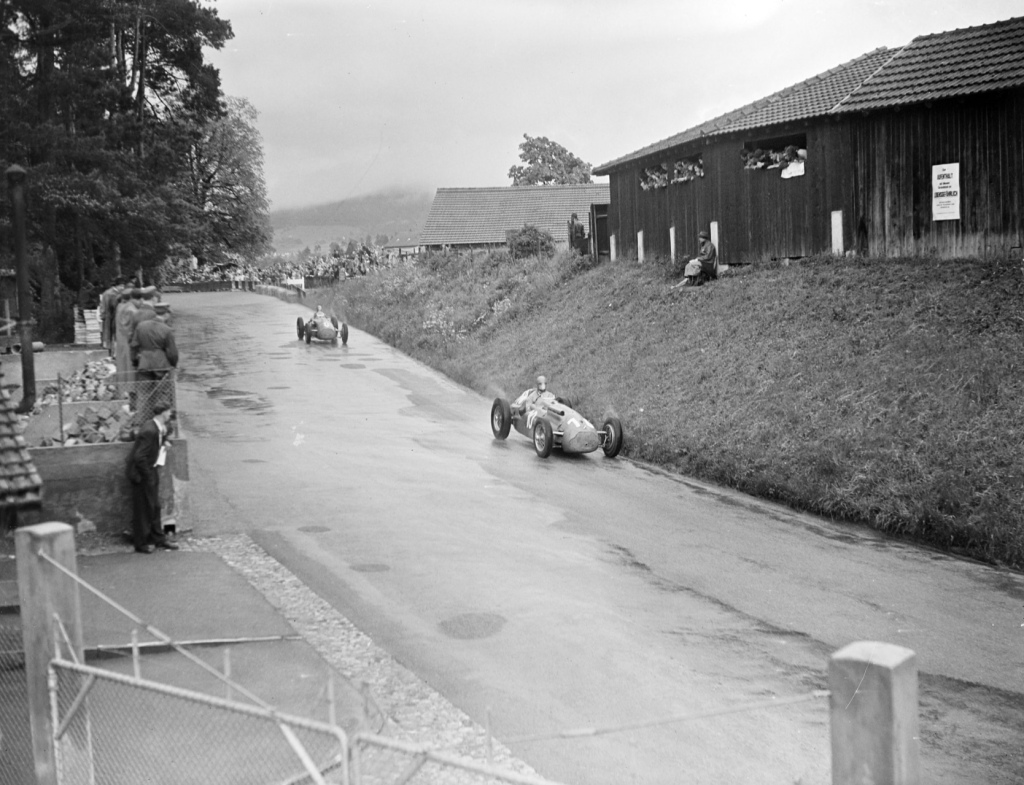
This shot of the Henri Louveau and Louis Rosier Talbot-Lago T26Cs shows rather well some of the perils of Bremgarten.
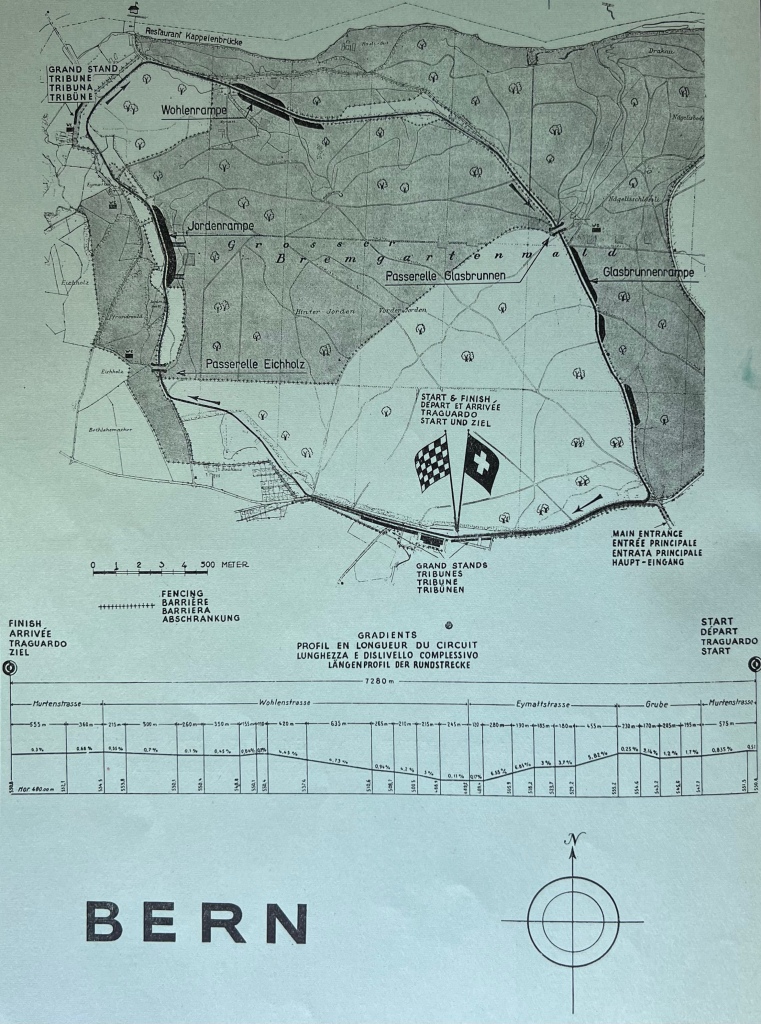
Finito…
The photograph of Fangio in the Spa pits tells a story. As Autocourse said, the hub and brake assembly had to be removed and a new tyre fitted to it. With one exception, everybody in the Alfa pits was in a frenzy. The exception, of course, was Fangio who sat calmly on the pit wall and let the mechanics get on with their job. Contrast that with Nuvolari at the 1935 German Grand Prix, perhaps the most excitable man in the team. Two means of achieving the same end.
Changing plugs on those V12 single cam Ferraris must have been a nightmare. One set was mounted within the engine V and special universally jointed spanners had to be used. On the 24-plug engine the second set were on the outside of the engine, between the exhausts. how many burnt fingers did it take?